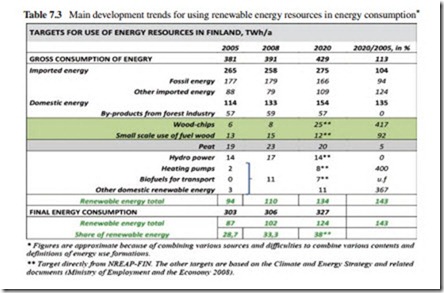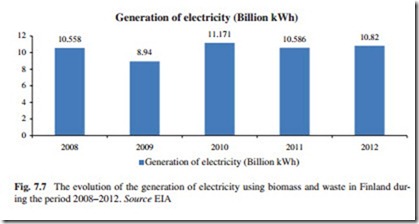Finland
Finland is a country with a high level of dependency on imported fuels and energy. For this reason, the cornerstones of Finnish energy policy are a diversified and reliable supply of energy and improved self-sufficiency. The energy-intensive basic industries, cold climate, and long distances underline the significance of energy for the country’s competitiveness and the well-being of its inhabitants.
Until the 1960s, Finland’s energy policy relied on the electricity produced by hydropower plants and the extensive use of wood. Due to the limited hydro resources, the use of coal and oil started to increase rapidly, and the need to find new energy sources has become clear. A gas pipeline from the former Soviet Union to Eastern Finland was completed in 1973 and later extended to the capital area and some other cities. The first nuclear power unit began operation in 1977, followed by three other units in 1979–1982 (Weckroth et al. 2011).
Energy sources in Finland can be divided as follows:
• Forest biomass or wood-based fuels;
• Field biomass;
• Peat biomass.
Forest biomass or wood-based fuels7: This type of fuel includes the whole tree and tree fiber wood as well as sawdust from the wood processing industry, wood shav- ings, and grinding dust. The types of trees are mainly pine (Pinus sylvestris) and spruce (Picea abies) as well as birch (Betula pubescens and B. pendula). Of the Finnish forest cover, 65 % is pine forest and 25 % spruce forest. Another signifi- cant wood energy source is also recycled wood, i.e., from dismantled buildings and other wood that has outlived its original use. Field biomass is a fuel that includes the by-products of growing grains: straw, chaff, and poor-quality grain. Field biomass plants that are grown only as a fuel are the hay plant reed canary grass (Phalaris arundinacea), as well as fast-growing willow species (Salix dasy- clados and Salix schweriinii).
It is important to highlight that of the Finnish landmass area about a quarter is wetland. Peat is cultivated from bogs as cut peat or gathered from the surface as milled peat. Finland is the world’s largest producer of energy peat. Of the mire area, about one-third is estimated as being in the natural state (Kilpinen et al. 2012).
The use of biomass for energy is influenced in Finland by state tax policy and incentive mechanisms. By adjusting energy taxation, the use of renewable energy sources could be encouraged. As it is, tax policy favors the use of electricity and oil burning, because tax on them has not, in general, being increased in order to encourage opting for the use of biomass. The state has made long-term investment decisions on favoring an increase in domestic electricity production, but in prac- tice, this means constructing more nuclear power capacity.
The EU national objective included in the NREAP for Finland (NREAP-FIN) is to cover 38 % of its energy consumption using renewable energy sources. According to information included in the NREAP-FIN and in the National Climate and Energy Strategy adopted by the government in 2013, the share of bio- energy in gross energy consumption is expected to rise to about 24 % in 2020 and the potential resources of the forest industry and forestry are estimated at 94 TWh per year in 2020. In order to reach this objective, there is a need for an increase in energy efficiency and a significant growth in the use of bioenergy.
The targets for the use of energy resources in Finland up to 2020 are included in Table 7.3.
A new production support scheme for the use of renewable energy sources entered into force in January 2011. It aims at supporting electricity production from wind power, wood chips, biogas as well as in small CHP plants using wood fuel. This support scheme also contains elements that encourage the efficient production of electricity and heat in CHP units. The scheme basically consists of market-based FiTs (feed-in premiums). In addition to the variable support, the production support scheme includes heat premiums for electricity produced using biogas or in a wood fuel plant. The support scheme is based on the Act on Production Support for Electricity from Renewable Energy Sources (1396/2010), which took full effect on March 25, 2011 (Weckroth et al. 2011).
Generation of Electricity Using Biomass and Waste
The evolution of the generation of electricity using biomass and waste in Finland during the period 2008–2012 is shown in Fig. 7.7.
According to Fig. 7.7, the generation of electricity in Finland using biomass and waste during the period 2008–2012 increased only 2.5 %. In 2009, the participation of biomass in the generation of electricity was over 10 % of the total.9 The peak in the generation of electricity was reached in 2010. It is expected that the use of this type of energy source for the generation of electricity in the country will continue increasing during the coming years, but a relatively small rate.

